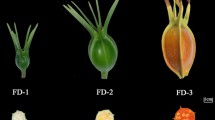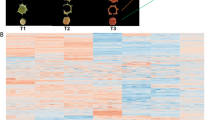Abstract
Fruits of the family, Rosaceae (Apple, cherry, Peach, strawberry, rose, raspberry) are rich source of phenolic and antioxidant compounds having anticancer properties. The present chapter discusses the detail information about anticancer compounds of strawberry, raspberry, peach, apple, cherry and rose and also the genes responsible for the biosynthesis, accumulation and transport of anticancer compounds during growth and maturation of fruits. The transcriptome expression was performed to find putative genes responsible for anticancer compounds during the biosynthesis and transporter genes. It is revealed form the promoter analysis that cis-acting element is responsible for the regulation of anticancer compounds. Thus, CRISPR/Cas9 enhanced the biosynthesis of anticancer compounds during fruit development and maturation stages. CRISPR/Cas9 will be used for the silencing of genes which putatively inhibit the formation of anti-cancer compounds and also up-regulate biosynthesis and transporter genes mediated by CRISPR/Cas9to enhance their accumulation in these fruits.
Access this chapter
Tax calculation will be finalised at checkout
Purchases are for personal use only
Similar content being viewed by others
References
Aluko RE (2012) Bioactive peptides. In: Functional foods and nutraceuticals. Springer, New York, pp 37–61
Amatori S, Mazzoni L, Alvarez-Suarez JM, Giampieri F, Gasparrini M, Forbes-Hernandez TY, Afrin S, Errico Provenzano A, Persico G, Mezzetti B, Amici A, Fanelli M, Battino M (2016) Polyphenol-rich strawberry extract (PRSE) shows in vitro and in vivo biological activity against invasive breast cancer cells. Sci Rep 6:30917. https://doi.org/10.1038/srep30917
Ames BN, Shigenaga MK, Hagen TM (1993) Oxidants, antioxidants, and the degenerative diseases of aging. Proc Natl Acad Sci U S A 90:7915–7922
Atkinson CJ, Dodds PAA, Ford YY, Le MiÈRe J, Taylor JM, Blake PS, Paul N (2006) Effects of cultivar, fruit number and reflected photosynthetically active radiation on Fragaria × ananassa productivity and fruit ellagic acid and ascorbic acid concentrations. Ann Bot 97:429–441
Bobe G, Wang B, Seeram NP, Nair MG, Bourquin LD (2006) Dietary anthocyanin-rich tart cherry extract inhibits intestinal tumorigenesis in APC(Min) mice fed suboptimal levels of sulindac. J Agric Food Chem 54:9322–9328
Brunetti C, Di Ferdinando M, Fini A, Pollastri S, Tattini M (2013) Flavonoids as antioxidants and developmental regulators: relative significance in plants and humans. Int J Mol Sci 14:3540–3555
Ceccarelli D, Talento C, Caboni E, Neri D (2016) Antioxidant activity and phenolic content in peach fruits from organic and integrated management. Acta Hortic 1137:201–206
Coates EM, Popa G, Gill CIR, McCann MJ, McDougall GJ, Stewart D, Rowland I (2007) Colon-available raspberry polyphenols exhibit anti-cancer effects on in vitro models of colon cancer. J Carcinogenesis 6:4. https://doi.org/10.1186/1477-3163-6-4
Espley RV, Hellens RP, Putterill J, Stevenson DE, Kutty-Amma S, Allan AC (2007) Red colouration in apple fruit is due to the activity of the MYB transcription factor, MdMYB10. Plant J 49:414–427
Feng R, Ni HM, Wang SY, Tourkova IL, Shurin MR, Harada H, Yin XM (2007) Cyanidin-3-rutinoside, a natural polyphenol antioxidant, selectively kills leukemic cells by induction of oxidative stress. J Biol Chem 282:13468–13476
Giampieri F, Tulipani S, Alvarez-Suarez JM, Quiles JL, Mezzetti B, Battino M (2012) The strawberry: composition, nutritional quality, and impact on human health. Nutrition 28:9–19
Jakobek L, Seruga M, Novak I, Medvidovic-Kosanovic M (2007) Flavonols, phenolic acids and antioxidant activity of some red fruits. Dtsch Lebensmitt Rundsch 103:369–378
Johnson JL, Bomser JA, Scheerens JC, Giusti MM (2011) Effect of black raspberry (Rubus occidentalis L.) extract variation conditioned by cultivar, production site, and fruit maturity stage on colon cancer cell proliferation. J Agric Food Chem 59:1638–1645
Jugdé H, Nguy D, Moller I, Cooney JM, Atkinson RG (2008) Isolation and characterization of a novel glycosyltransferase that converts phloretin to phlorizin, a potent antioxidant in apple. FEBS J 275:3804–3814
Kang SY, Seeram NP, Nair MG, Bourquin LD (2003) Tart cherry anthocyanins inhibit tumor development in ApcMin mice and reduce proliferation of human colon cancer cells. Cancer Lett 194:13–19
Kern M, Pahlke G, Balavenkatraman KK, Bohmer FD, Marko D (2007) Apple polyphenols affect protein kinase C activity and the onset of apoptosis in human colon carcinoma cells. J Agric Food Chem 55:4999–5006
Kristo AS, Klimis-Zacas D, Sikalidis AK (2016) Protective role of dietary berries in cancer. Antioxidants 5:E37. https://doi.org/10.3390/antiox5040037
Landete JM (2011) Ellagitannins, ellagic acid and their derived metabolites: a review about source, metabolism, functions and health. Food Res Int 44:1150–1160
Lea MA, Ibeh C, des Bordes C, Vizzotto M, Cisneros-Zevallos L, Byrne DH, Okie WR, Moyer MP (2008) Inhibition of growth and induction of differentiation of colon cancer cells by peach and plum phenolic compounds. Anticancer Res 28:2067–2076
Lescot M, Dehais P, Thijs G, Marchal K, Moreau Y, Van de Peer Y, Rouze P, Rombauts S (2002) PlantCARE, a database of plant cis-acting regulatory elements and a portal to tools for in silico analysis of promoter sequences. Nucleic Acids Res 30:325–327
Lin-Wang K, Bolitho K, Grafton K, Kortstee A, Karunairetnam S, McGhie TK, Espley RV, Hellens RP, Allan AC (2010) An R2R3 MYB transcription factor associated with regulation of the anthocyanin biosynthetic pathway in Rosaceae. BMC Plant Biol 10:50. https://doi.org/10.1186/1471-2229-10-50
Lin-Wang K, McGhie TK, Wang M, Liu Y, Warren B, Storey R, Espley RV, Allan AC (2014) Engineering the anthocyanin regulatory complex of strawberry (Fragaria vesca). Front Plant Sci 5:651. https://doi.org/10.3389/fpls.2014.00651
Losso J, Bansode R, Trappey A, Bawadi H, Truax R (2004) In vitro anti-proliferative activities of ellagic acid. J Nutr Biochem 15:672–678
Lowder LG, Zhang D, Baltes NJ, Paul JW, Tang X, Zheng X, Voytas DF, Hsieh T-F, Zhang Y, Qi Y (2015) A CRISPR/Cas9 toolbox for multiplexed plant genome editing and transcriptional regulation. Plant Physiol 169:971–985
Ma L, Wang R, Nan Y, Li W, Wang Q, Jin F (2016a) Phloretin exhibits an anticancer effect and enhances the anticancer ability of cisplatin on non-small cell lung cancer cell lines by regulating expression of apoptotic pathways and matrix metalloproteinases. Int J Oncol 48:843–853
Ma X, Zhu Q, Chen Y, Liu YG (2016b) CRISPR/Cas9 platforms for genome editing in plants: developments and applications. Mol Plant 9:961–974
Määttä-Riihinen KR, Kamal-Eldin A, Törrönen AR (2004) Identification and quantification of phenolic compounds in berries of Fragaria and Rubus species (family Rosaceae). J Agric Food Chem 52:6178–6187
Mastrangelo D, Massai L, Fioritoni G, Lo Coco F, Nuti R (2016) The cure from nature: the extraordinary anticancer properties of ascorbate (vitamin C). J Integr Oncol 5:157. https://doi.org/10.4172/2329-6771.1000157
Medina-Puche L, Cumplido-Laso G, Amil-Ruiz F, Hoffmann T, Ring L, Rodríguez-Franco A, Caballero JL, Schwab W, Muñoz-Blanco J, Blanco-Portales R (2014) MYB10 plays a major role in the regulation of flavonoid/phenylpropanoid metabolism during ripening of Fragaria × ananassa fruits. J Exp Bot 65:401–417
Merzlyak MN, Solovchenko AE, Gitelson AA (2003) Reflectance spectral features and non-destructive estimation of chlorophyll, carotenoid and anthocyanin content in apple fruit. Postharvest Biol Technol 27:197–211
Miret JA, Munné-Bosch S (2016) Abscisic acid and pyrabactin improve vitamin C contents in raspberries. Food Chem 203:216–223
Miyaji T, Kuromori T, Takeuchi Y, Yamaji N, Yokosho K, Shimazawa A, Sugimoto E, Omote H, Ma JF, Shinozaki K, Moriyama Y (2015) AtPHT4;4 is a chloroplast-localized ascorbate transporter in Arabidopsis. Nat Commun 6:5928. https://doi.org/10.1038/ncomms6928
Niggeweg R, Michael AJ, Martin C (2004) Engineering plants with increased levels of the antioxidant chlorogenic acid. Nat Biotech 22:746–754
Noratto G, Porter W, Byrne D, Cisneros-Zevallos L (2009) Identifying peach and plum polyphenols with chemopreventive potential against estrogen-independent breast cancer cells. J Agric Food Chem 57:5219–5226
Nowak R (2006) Determination of ellagic acid in pseudofruits of some species of roses. Acta Pol Pharm 63:289–292
Ogur R, Istanbulluoglu H, Korkmaz A, Barla A, Tekbas OF, Oztas E (2014) Report: investigation of anticancer effects of cherry in vitro. Pak J Pharm Sci 27:587–592
Oprica L, Bucsa C, Zamfirache MM (2016) Evaluation of some phytochemical constituents and the antioxidant activity in six rose hips species collected from different altitude of suceava district. Ann Alexandru loan Cuza Univ Sect II a. Genet Mol Biol 17:1–9
Payyavula RS, Shakya R, Sengoda VG, Munyaneza JE, Swamy P, Navarre DA (2015) Synthesis and regulation of chlorogenic acid in potato: rerouting phenylpropanoid flux in HQT-silenced lines. Plant Biotechnol J 13:551–564
Qin X, Xing YF, Zhou Z, Yao Y (2015) Dihydrochalcone compounds isolated from crabapple leaves showed anticancer effects on human cancer cell lines. Molecules 20:21193–21203
Ravaglia D, Espley RV, Henry-Kirk RA, Andreotti C, Ziosi V, Hellens RP, Costa G, Allan AC (2013) Transcriptional regulation of flavonoid biosynthesis in nectarine (Prunus persica) by a set of R2R3 MYB transcription factors. BMC Plant Biol 13:68. https://doi.org/10.1186/1471-2229-13-68
Sameeullah M, Sasaki T, Yamamoto Y (2013) Sucrose transporter NtSUT1 confers aluminum tolerance on cultured cells of tobacco (Nicotiana tabacum L). Soil Sci Plant Nutr 59:756–770
Sameeullah M, Khan FA, Ozer G, Aslam N, Gurel E, Waheed MT, Karadeniz T (2017) CRISPR/Cas9-mediated immunity in plants against pathogens. In: Jamal M (ed) The CRISPR/Cas system: emerging technology and application. Caister Academic Press, Poole, pp 55–64
Schulenburg K, Feller A, Hoffmann T, Schecker JH, Martens S, Schwab W (2016) Formation of β-glucogallin, the precursor of ellagic acid in strawberry and raspberry. J Exp Bot 67:2299–2308
Sharma M, Li L, Celver J, Killian C, Kovoor A, Seeram NP (2010) Effects of fruit ellagitannin extracts, ellagic acid, and their colonic metabolite, urolithin A, on Wnt signaling. J Agric Food Chem 58:3965–3969
Siegel R, Ma J, Zou Z, Jemal A (2014) Cancer statistics, 2014. CA Cancer J Clin 64:9–29
Steinmetz KA, Potter JD (1996) Vegetables, fruit, and cancer prevention: a review. J Am Diet Assoc 96:1027–1039
USDA (2015) National nutrient database for standard reference, release 28. Version current: September 2015, slightly revised May 2016 (https://www.ars.usda.gov/ northeast-area/beltsville-md/beltsville-human-nutrition-research-center/nutrient-data-laboratory/docs/usda-national-nutrient-database-for-standard-reference. Accessed on 25 Nov 2017)
van der Reest J, Gottlieb E (2016) Anti-cancer effects of vitamin C revisited. Cell Res 26:269–270
Velioglu YS, Mazza G, Gao L, Oomah BD (1998) Antioxidant activity and total phenolics in selected fruits, vegetables, and grain products. J Agric Food Chem 46:4113–4117
Wang YH, Irving HR (2011) Developing a model of plant hormone interactions. Plant Signal Behav 6:494–500
Wang SY, Lin HS (2000) Antioxidant activity in fruits and leaves of blackberry, raspberry, and strawberry varies with cultivar and developmental stage. J Agric Food Chem 48:140–146
Wang LS, Stoner GD (2008) Anthocyanins and their role in cancer prevention. Cancer Lett 269:281–290
Wang H, Cao G, Prior RL (1996) Total antioxidant capacity of fruits. J Agric Food Chem 44:701–705
Willett WC (1994) Micronutrients and cancer risk. Am J Clin Nutr 59:S1162–S1165
Williner MR, Pirovani ME, Güemes DR (2003) Ellagic acid content in strawberries of different cultivars and ripening stages. J Sci Food Agric 83:842–845
Yang KC, Tsai CY, Wang YJ, Wei PL, Lee CH, Chen JH, Wu CH, Ho YS (2009) Apple polyphenol phloretin potentiates the anticancer actions of paclitaxel through induction of apoptosis in human hep G2 cells. Mol Carcinog 48:420–431
Yun J, Mullarky E, Lu C, Bosch KN, Kavalier A, Rivera K, Roper J, Chio IIC, Giannopoulou EG, Rago C, Muley A, Asara JM, Paik J, Elemento O, Chen Z, Pappin DJ, Dow LE, Papadopoulos N, Gross SS, Cantley LC (2015) Vitamin C selectively kills KRAS and BRAF mutant colorectal cancer cells by targeting GAPDH. Science 350:1391–1396
Zhong L (2017) Anticancer effects of bioactive compounds from rose hip fruit in human breast cancer cell lines. PhD thesis, Swedish University of Agricultural Sciences, Sweden
Author information
Authors and Affiliations
Corresponding author
Editor information
Editors and Affiliations
Rights and permissions
Copyright information
© 2018 Springer Nature Singapore Pte Ltd.
About this chapter
Cite this chapter
Sameeullah, M., Gündoğdu, M., Canan, İ., Karadeniz, T., Aasim, M., Khawar, K.M. (2018). Fruits of Rosaceae Family as a Source of Anticancer Compounds and Molecular Innovations. In: Akhtar, M., Swamy, M. (eds) Anticancer Plants: Mechanisms and Molecular Interactions. Springer, Singapore. https://doi.org/10.1007/978-981-10-8417-1_13
Download citation
DOI: https://doi.org/10.1007/978-981-10-8417-1_13
Published:
Publisher Name: Springer, Singapore
Print ISBN: 978-981-10-8416-4
Online ISBN: 978-981-10-8417-1
eBook Packages: Biomedical and Life SciencesBiomedical and Life Sciences (R0)




